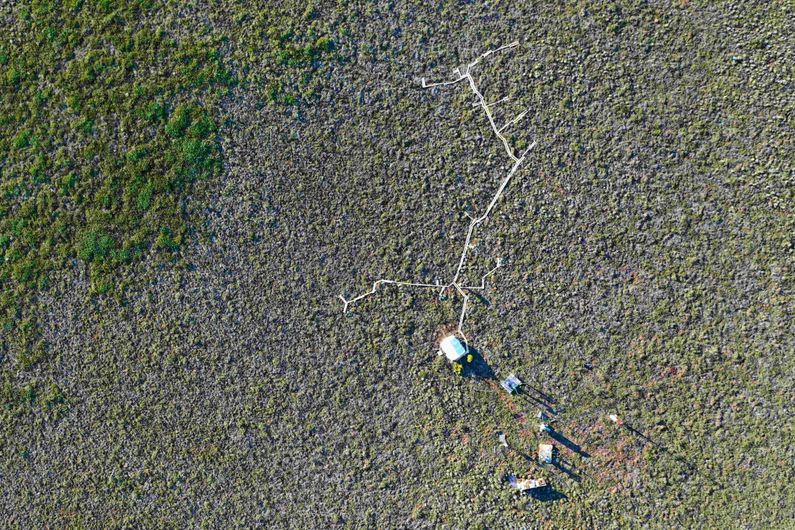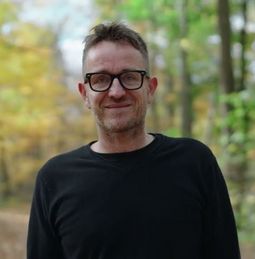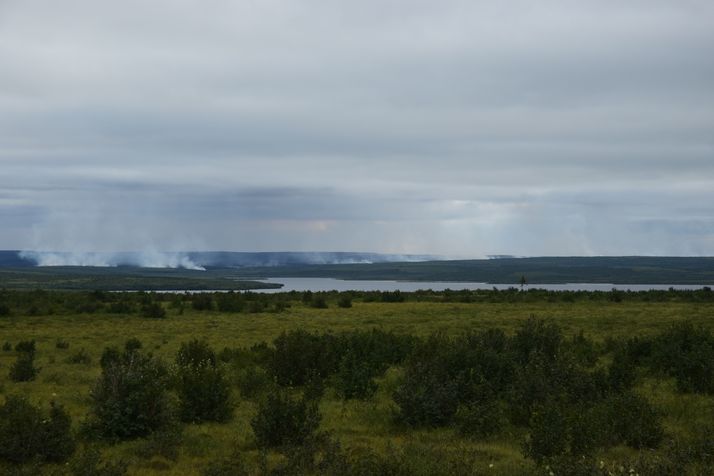Reevaluating the Arctic's greenhouse gases
- Salle de presse
08/31/2023
- UdeMNouvelles

Aerial view taken by drone in June 2019 of the upland tundra site at Trail Valley Creek in Canada's Northwest Territories where automated and manual chamber gas flux measurements are taken. The boardwalk provides access to each chamber site without disturbing the vegetation and affecting gas fluxes within the chambers, the white tent houses the gas analyzer and control system for the automated chamber system, and a micrometeorological station and eddy covariance tower can be seen at the bottom of the photo.
Credit: Gabriel Hould GosselinThe magnitude of methane uptake in upland "sinks" may be larger than previously thought, and may increase under dry conditions, an UdeM-led study finds.
Located in low-lying areas saturated with water, the wetlands that make up 14 per cent of the Arctic emit vast quantities of methane, a potent greenhouse gas. But scientists believe these emissions may be mitigated by the atmospheric methane uptake that occurs in the Arctic's uplands, which are well-drained and cover more than 80 per cent of the polar region.
So far, however, scientists have had trouble measuring, understanding and evaluating the underlying mechanisms, environmental controls and magnitude of methane uptake in these so-called upland "sinks". Now an international study finds this uptake may be larger than previously thought, and that it may increase under drier conditions.
Led by Université de Montréal geography professor Oliver Sonnentag with his former postdoctoral researcher Carolina Voigt, the study is published today in Nature Climate Change.
"Scientists in the Arctic tend to install all their flux measurement instrumentation at locations where high methane emissions can be expected, and our work reduces this bias by quantifying methane uptake in the uplands and by shedding light on the controls of that uptake," said Sonnentag, a Canada Research Chair in atmospheric biosciences who designed the study and is its principal investigator.
At Trail Valley Creek, an upland tundra site on permafrost 45 kilometres north of Inuvik, Northwest Territories, in the western Canadian Arctic, the UdeM team used a unique experimental set-up consisting of 18 automated chambers to continuously measure methane fluxes. No other automated chamber system exists this far north in the Canadian Arctic, and only few exist above the Arctic Circle globally, most of them installed at sites where methane emissions are significant.
40,000 hi-res measurements
Recorded between June and August in 2019 and 2021, the more than 40,000 high-resolution measurements of methane fluxes were made over three common vegetation types: dwarf-shrub tundra with lichen cover (but no vascular plants), deciduous and evergreen dwarf shrub cover, and tussock cover. Additional measurements, this time done manually, were made at three additional Arctic sites located in western Canada and in Finland's Lapland region.
The measurements revealed previously unknown 24-hour and seasonal dynamics in methane uptake: in early and peak summer it was largest during the afternoons, coinciding with maximum soil temperature, but in late summer it peaked during the night.
"Methane uptake was also closely linked to ecosystem carbon dioxide respiration, where the largest methane uptake occurred at high ecosystem respiration rates," said Voigt, now a research associate at the University of Hamburg. "Supported by laboratory studies, our study hints at a link between methane uptake and labile (decomposing) carbon and nutrient supply."
"Our findings imply that soil drying and enhanced nutrient supply will promote methane uptake by Arctic soils, providing a negative feedback to global climate change," the authors conclude in their study. "Considering the immense gaseous and lateral losses of carbon associated with thawing permafrost and their climatic impact, we need to understand natural sinks, their capacity to balance emissions, and their response to a changing Arctic."
About this study
"Arctic soil methane sink increases with drier conditions and higher ecosystem respiration," by Carolina Voigt et al., was published Aug. 31, 2023 in Nature Climate Change. The study was led by Université de Montréal, in collaboration with Wilfrid Laurier University and University of Eastern Finland, and scientists in Germany, Finland, Canada and the United States. Funding was provided by the Academy of Finland project MUFFIN, the Canada Foundation for Innovation project Changing Arctic Network, ArcticNet and the Canada Research Chair and NSERC Discovery Grants programs. Field work was supported by Metsähallitus and the Aurora Research Institute.
Long-running Arctic research site threatened by wildfires
The unprecedented wildfires that have wreaked havoc in the Northwest Territories this summer have also disrupted one of Canada's longest running Arctic research sites: Trail Valley Creek near Inuvik with its unique UdeM-operated carbon flux measurement set-up.
"A few weeks ago, I was notified that there was a tundra fire threatening the site," said UdeM geography professor Oliver Sonnentag, lead investigator of the study featuring his ongoing research at Trail Valley Creek that is published today in Nature Climate Change.
"The problem was air quality: so much smoke was pushed into our camp that we had to evacuate our people there to Inuvik overnight and shuttle them back during the day whenever conditions improved."
Sonnentag hoped to avert the disaster that last year befell a separate site he's involved in in the Dehcho region in the southern Northwest Territories, the Scotty Creek Research Station south of Fort Simpson: filled with expensive equipment, the Indigenous-led facility all but burnt to the ground as forest fires swept in.
“This time, at Trail Valley Creek, we were able to safely remove some of the instrumentation not covered by our insurance policy including equipment to support remote sensing work," said Sonnentag. "All the portable stuff, we got out of camp to Inuvik."
Temperatures eventually dropped, the nights got cooler, it began to drizzle, and though the fires continue to burn near the camp, they have stopped moving. Yesterday Sonnentag dispatched a small team of graduate students led by his research associate Gabriel Hould Gosselin to Inuvik to winterize the carbon flux instrumentation.
"The main challenge for us is that all the helicopters in Inuvik aren't available; they're busy fighting the fires. But after some negotiation we were able to secure one for a single day to get our equipment winterized.
"It has to be done. Up there, once winter hits it can go down to minus 40 degrees, and we can't let hundred of thousands of dollars of equipment get destroyed by the elements."
Media contact
-
Jeff Heinrich
Université de Montréal
Tel: 514 343-7593











